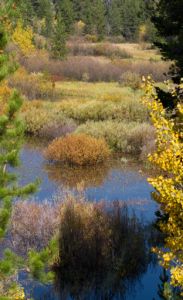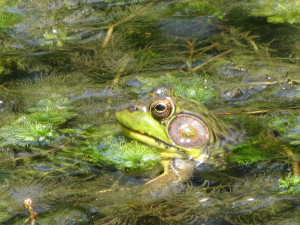By Renee Chasse, UNH Neuroscience & Behavior Program | MAY 2017
“Our ability to perceive quality in nature begins as in art with the pretty. It expands through successive stages of the beautiful to values as yet uncaptured by language.”
– Aldo Leopold (‘Marshland Elegy’, A Sand County Almanac)
When you imagine Nature’s beauty, what do you think of? A rosy sunset observed from a distant mountaintop? Tranquil forests filled with woodland animals? Or do you picture the thundering sea – chaotic, yet somehow peaceful? While beauty is absolutely in the eye of the beholder, there’s a good chance that swamps, and other types of wetlands, are underappreciated by most of us. Yet these ecosystems are fantastically intricate and critically important.

What first comes to mind when you hear the word wetland? The first thing I think of is my favorite green ogre who lives in a swamp (that’s right, Shrek!). In movies, swamps tend to represent faraway, hidden places with mystical qualities (or mystical residents). Offscreen, wetlands are defined as low-lying areas that contain shallow water or water-logged soil for at least a part of the year, and they come in all shapes and sizes. Wetlands provide critical habitat for a diversity of plants and animals, and more than one-third of federally threatened and endangered species rely on wetlands for their survival. Wetlands also provide invaluable environmental services, including water filtration and flood control, to humans and non-human wildlife.
Wetlands are analogous to the human kidneys—they filter, clean, and store water; and they absorb excess sediment, nutrients, and other pollutants, preventing them from reaching rivers, lakes, and the ocean. And just as a loss of kidney function can be detrimental to the human body, the loss of wetlands can lead to flooding, water contamination (due to lost filtration capacity), and loss of habitat for wetland-dependent species (including our lovable ogres and Jedi Masters).
Are wetlands really in danger? Yes! Approximately 60 percent of our planet’s wetlands have been lost over the past 100 years. And the degree of wetland loss is even higher in some regions—there has been a 90 percent loss of wetlands in Europe, and a 90 percent loss of freshwater wetlands in Malaysia for rice cultivation. In addition to a reduction in habitat and water filtration capacity, wetland loss can lead to higher concentrations of greenhouse gases because the carbon trapped in wetland soils is released to the atmosphere when wetlands are disturbed.
What can we do about this? After reading this far, you’re probably wondering “What can I do to change this?” More than you think!
- Support wetland conservation. NOAA’s website lists “10 things you can do.” Challenge yourself to do at least one of them.
- Volunteer your time and donate to one of the organizations working hard to protect wetlands worldwide – Wetlands International, America’s Wetlands Foundation, & The Nature Conservancy, to name a few.
- Get outside and cultivate an appreciation for nature, including wetland habitats and wetland-dependent species. Go for a hike. Sit by a pond to observe, read, or sketch. Learn about the types of wetlands, and start to explore them. If, one by one, we deepen our appreciation and connection to Nature, we will collectively become better stewards of this world we rely on.
References | Resources
- America’s Wetland Foundation. https://www.americaswetland.com/
- Defenders of Wildlife. “Fact Sheet: Wetlands.” 23 March 2017. Web. http://www.defenders.org/wetlands/basic-facts.
- National Oceanic and Atmospheric Administration (NOAA). “Habitat Conservation: Coastal Wetlands.” 19 May 2017. Web. http://www.habitat.noaa.gov/protection/wetlands/whatyoucando.html
- National Ocean Service, NOAA. “What is a Wetland?” 23 March 2017 Web. http://oceanservice.noaa.gov/facts/wetland.html.
- Oddizzi. “Explore the World: Wetlands.” 30 April 2017. Web. http://www.oddizzi.com/teachers/explore-the-world/global-knowledge/environmental-change/how-is-it-changing/wetlands/.
- The Nature Conservancy. https://www.nature.org/.
- Wetlands International. https://www.wetlands.org/.
Renee Chasse is currently a student in the Neuroscience & Behavior Program at the University of New Hampshire (UNH). Renee is from a small town in Connecticut, near the edge of a beautiful lake. Growing up at the water’s edge instilled in Renee a sense of wonder and appreciation for wetlands and other freshwater environments. After graduation, Renee plans to attend pharmacy school.
